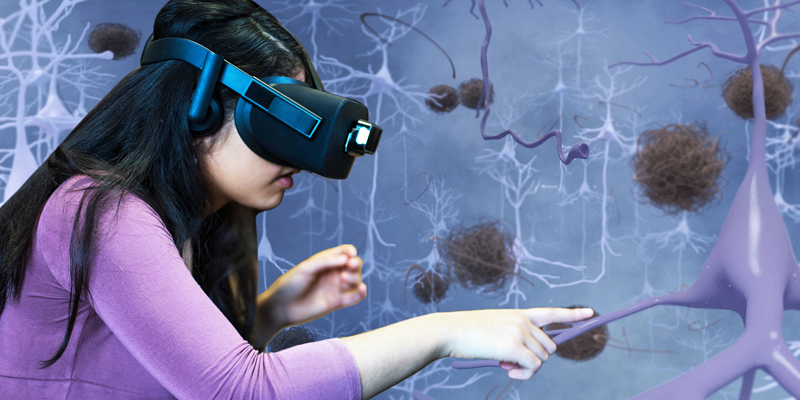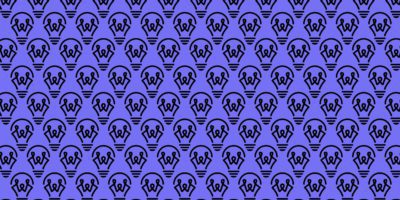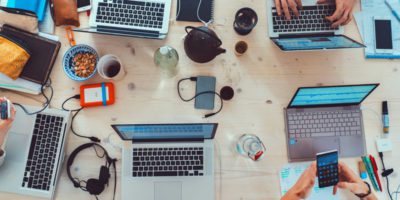Carrie Shaw is the founder and CEO of Embodied Labs, an immersive training and wellness platform for professional and family caregivers, which she founded in 2016. Carrie works at the intersection of health education and virtual reality storytelling, having set up Embodied Labs after working as her mother’s primary caregiver, who’s diagnosis of Early Onset Alzheimer’s disease opened Carrie’s eyes to the needs of caregivers and the aging services workforce. Carrie graduated from UNC Chapel Hill with a Bachelor of Science in Public Health and she also holds a Master’s of Science in Biomedical Visualization from the University of Illinois at Chicago.
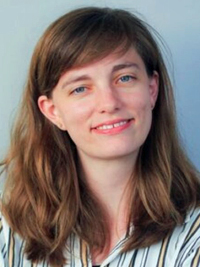
“I was shocked to uncover the statistics that less than 2% of female founded businesses received venture capital in 2018. Sometimes I would sit alone in my makeshift home office, in foetal position, wondering why I thought I had the right to do what I was doing. I had no experience building a business. I didn’t know how to raise capital.”
The magic loophole?
When I was 12, I won my middle school science fair. I got to leave campus and participate in the county-wide science fair – in which coincidentally, I happened to win 3rd place. I got to leave school for the day and win money, all to do something I quite enjoyed – explain my scientific curiosity to my local community.
If I had won first place instead of third, I would have gotten to miss more school and go on to the district fair. Was this a magical loophole? A way to get out of boring classes where at the height of my awkward nerdy phase I was as far from being in the popular crowd as could be? It all seemed too good to be true.
Success on the science fair circuit
For every year after that, six in total, until I went to college, I competed in the science fair and I was out to win. I won first place in county, district, state and eventually at the international science fairs from 10th to 12th grade. The height of my science fair career came when in my senior year of high school, I won first-place prize in the Medicine and Health category of the Intel International Science Fair, that hosted 14,000 kids from 55+ countries to gather for one week of intense community and competition in a rotating city each year. I had saved $10k of science fair winnings to put toward my college education and had become obsessed with the field of cancer research.
An idealistic determination to cure cancer
I entered college at UNC-Chapel Hill with an idealistic determination to cure cancer, planning to major in biochemistry and become an academic scientist with my own research lab. That same year, I realised a few things.
First, I still hated being in the classroom – I preferred the time spent in the lab (I sought out an admired researcher in the field of microRNA and convinced him to let me intern there), immersed in experimentation and inquisitive, an iterative study design that we would collectively discuss at weekly lab meetings. Moreover, my grades were terrible and I couldn’t compete with the 400+ students, most aspiring to become medical doctors, who had to undergo the “weed out” process of such a competitive track and who were most adept at mastering multiple-choice tests three times a semester.
Discovering my mom had Early Onset Alzheimer’s disease
I realised cancer was incredibly complex and wondered if a student making Cs at best in my course work had any business thinking I could cure it. At the same time, my mom got a diagnosis – she had Early Onset Alzheimer’s disease.
I was nearly half her age and wondered – was this disease, known for transmitting at a 1:2 ratio to offspring, going to impact me? Was my life “halfway” over? I left college for a semester, hoping to find myself, rethink my motivations and aspirations and grieve the news that my mother had been given and the impact it would have on our family in the years that followed.
Breaking free from the lab
Most of my teenage years had been spent working inside a lab, organising Petri dishes of cancer cells being dosed with various amounts of anti-cancer drugs and then studied for their protein responses in long experiments. I’d have to adhere to a precise time schedule in between high school class and soccer practice to make sure I could move this dye to this gel or turn this electrode on and that one-off exactly a set amount of minutes apart to measure the accurate response.
But once my mom got diagnosed, I wondered, “How had I spent so much time in a lab when life is so short?” I decided I must travel and see some of the countries I had learned about from my fellow “science fair nerds” that became my window into the wider world during those international annual events.
I joined the World Wide Organic Opportunities on Organic Farms network and took off for Central America. I used my science fair winnings to book my flights then hopped from a coffee farm in Nicaragua to a sustainable living community in Costa Rica as I worked in exchange for my room and board.
I realised that I had a passion for human life, a hunger to live fast and discover the world beyond the Petri dish in the lab. I returned back to college the next semester and switched my major to a Bachelor’s of Science in Public Health, with a focus on epidemiology and global health.
Where computer science meets public health
Having opened a flood gate for understanding human health at a global scale with a particular interest in Latin America, I applied for a grant to work at an NGO clinic in Cusco, Peru, the following summer. I discovered that the clinic had a pain point – their medical records were all kept in filing cabinets as paper after paper.
Not only were they hard to access and keep track of, but the clinic also could not apply for grants because they could not aggregate meaningful data about the impact of their work on the populations they served. The nurses were young, all had Blackberries and sometimes a tablet or computer of their own. What if they had an electronic medical record instead of, or in parallel to, a paper filing system?
I returned back to school the next year and joined Engineers Without Borders. I recruited a team of one Master’s Student, getting a degree in Computer Science and Public Health and two other students interested in figuring out a sustainable way to build, implement and train the NGO workers on how to use this as an effective tool.
The power of open source
I discovered Paul Farmer’s work, particular in this case, his Open Medical Record System, an open-source medical record code base that was created to give organisations without the immense cash it requires to purchase a medical record system, the ability to build them for free.
We replicated their paper filing system using OpenMRS, fundraised to purchase small laptop computers for each nurse that could be taken into the field on home visits, and made a trip back to the clinic to deliver the computers and train the staff on how to use the system.
I was hooked on population health, reading every book by Paul Farmer that I could find. That was the first time I learned about Haiti and the Dominican Republic, the island where Paul Farmer’s work started. My curiosity about how these two countries co-existed but with distinct cultures and a wide gap in socioeconomic and environmental health fascinated me.
When I graduated from UNC-Chapel Hill and applied for the Peace Corps, it felt like it was “meant to be” when I received my placement as a Community Health Education volunteer in the Dominican Republic.
I spent two years in the Peace Corps, hoping to return to the United States and get a job working with the Gates Foundation or PATH International or perhaps become an academic professor in epidemiology and ethnography.
All in all, the Peace Corps was a humbling and deeply challenging experience. It was idealistic to think I was there to change something for the better in a culture, not my own and a language I did not speak. I felt I learned more than I could return and took on a new appreciation for what it meant to be American and to have the ability to strive to do the most good for the most people.
Returning home to care for my mom
However, when I returned from the Peace Corps at age 24, I needed to do the most good for my own family. My mom was more advanced in her Alzheimer’s and with my dad working full time, she needed daily care.
I worked part time jobs as I helped my dad care for my mom. Eventually, she needed around the clock care from home health aides as she could no longer bathe, eat, walk or talk. The two years I lived with her taught me that my mom and I could have a blossoming relationship, even in the latest stages of her disease.
I had spent time travelling anywhere I could, in part because I was figuring out my career, but also because I had been afraid to be near her. I didn’t understand her disease or how to have a relationship with her as her brain was changing.
My time with her taught me to be present every day. To be creative, flexible and patient. To face my deepest fears of having the toughest conversations and heart-breaking moments and realise that we could come out healed and stronger because of them.
I left my mom two years before she would die of her disease to go back to graduate school to pursue a Master’s in Biomedical Visualization at The University of Illinois Chicago. I had realised in the Peace Corps that I had an undiscovered knack for drawing and that if I could draw about health it would transcend all language, culture and education barriers.
Enabling healthcare providers to step into their patient’s perspective
While caring for my mom, I realised if I could explain to her care team what she was experiencing through her eyes, we could all learn to care for her faster. For my thesis research, I asked – if healthcare providers could step into their patient’s perspective, would this make us more effective in providing care?
At first, I had no idea how I would answer this question. With my eyes open to what it means to age in this world, I knew I wanted to continue to focus on aging issues.
A much-needed boost for the field of geriatric medicine
The director of simulation for the University of Illinois College of Medicine was on my committee, and through talking with her, I learned that the field of geriatric medicine is one that is not highly sought after by students due to lack of exposure, esteem for the work and pay.
Many schools spend as little as four hours in total teaching geriatric medicine in their first and second-year curriculum. Aging and ageism are prevalent and there is a stigma that working with older adults as a career is undesirable, not worthy of regard or esteem. When looking at pay for those working with older adults, there is significantly less money in these occupations.
I learned that in the limited education UIC students got for the geriatric medicine curriculum, they would walk through what is called an “unfolding paper case” where they would read a story about an older man, coming to the doctor with delirium, depression and dementia. I wondered, how could we create this story in the first-person perspective and let these medical students ‘live’ his experience, rather than read it on a worksheet.
Embracing virtual reality
I was taking a class on game engine design for artists when a classmate from the human-computer interaction programme learned what I was trying to build. Passionate about how technology can help humans better understand each other, he enthusiastically introduced me to virtual reality. We developed a workflow to take 360 live-action films and create interactive experiences through gaze, gesture and voice so that when inside a virtual reality headset, a person could become another and learn from that experience.
When we began working in virtual reality, I became obsessed with reading about the decades of research on simulation training, learning in immersive worlds, the theories of embodied cognition and embodied learning, and all things related to presence/immersion and impact from immersive worlds.
A thesis that turned into a company
My thesis project became my company today – Embodied Labs. We – my then classmate turned co-founder, Thomas Leahy and I, founded it in August 2016, the same month that my mom died. Four years later, we have developed a platform to deliver immersive training experiences and measure their impact outcomes.
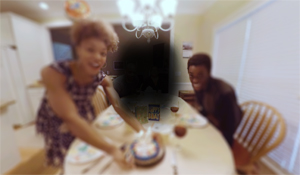
Experiences to give flipped perspective
We explore varying life scenarios like what it means to need a care team in your home, make a transition to live in a care community, find care services as an LGBT+ older adult or experience the end of life with your family and a home hospice team around you.
The experiences allow people to first-hand embody someone living with macular degeneration and hearing loss, early, middle and late-stage Alzheimer’s disease, Lewy Body Dementia and Parkinson’s, terminal cancer and gender identity transformation.
We also created experiences to give the flipped perspective to actually practice our roles as caregivers in these scenarios, with the knowledge of what it looks and feels like from the perspective of the person who is being cared for.
Gaining traction
Embodied Labs began as an idea with one immersive experience on an 80GB hard drive, that worked only on the HTC Vive and Oculus Rift pre-commercialization development kits. For our first year, we figured out how to build a distribution platform, more training labs, and a data/analytics capture system so that we could bring the product to market.

However, we realised that immersive technology was hard to figure out, especially for our customer base, no one was interested in the technology, but rather the solution.
Bundling solutions
Since 2018, we have sold our product as a hardware/software bundle (or software only for groups that already have the hardware) as an annual subscription to our platform. Most customers set up immersive learning labs onsite and put their employees through training in a 1:1 or in-person group mode session, where one person is in the headset and the experience is projected onto a screen and speakers so that a group can engage together.
Early on, we had to prove our credibility both in our idea and as a team of first-time entrepreneurs – majority-female at that, in a tech-start-up ecosystem where less than 2% of all venture capital funding goes to female-founded companies.
Building a winning team
We won the Creative Startups accelerator in 2016 and met our first angel investor, an advisor in that programme who put pre-seed capital into our company. By 2017, we had won Finalist from hundreds of applicants in the US Department of Ed Education Simulation challenge and First Place in United Health Care and AARP’s Caregiving for Dementia Challenge.
In 2018, we won the grand prize in the Bill and Melinda Gates Global XR in Education Challenge, which came with a $250k cash award to further our business. I was asked to speak at countless events focused on aging, technology and caregiving and our customer base began to grow from only ten customers in 2017 to 50 in 2018 and more than 150 today and counting.
In 2019, we met the Ziegler-Linkage Fund, who became the lead investor in our Seed round of capital, $3.2M which we closed in January of 2020 with four other venture capital firms that spanned digital health, workforce technology and spatial computing.
Just. Don’t. Quit.
When it comes to building Embodied Labs, raising money to grow this business has been the greatest learning process of all. As a first-time founder, new to the start-up and tech landscape, I did not know anything about venture capital.
I remember having idealistic thoughts that we would incorporate our business and surely find financing within six months to grow our brilliant idea into something more. Instead, I realised that venture capital, much like my experience in the Peace Corps, required me to learn a language and culture unique to the industry and necessary for our success in navigating it.
I was shocked to uncover the statistics that less than 2% of female-founded businesses received venture capital in 2018. Sometimes I would sit alone in my makeshift home office, in foetal position, wondering why I thought I had the right to do what I was doing. I had no experience building a business. I didn’t know how to raise capital.
If I did the math, of course, I was statistically incredibly unlikely to get it, even if I did have the background and experience. Yet, every day I would wake up with a knot in my stomach, force myself out of bed and say “just make a little progress today – forward, backward or to the side – progress all the same” and “whatever you do, Just. Don’t. Quit.”
Avoiding the sharks
Little by little, I learned the ropes. There were of course the sharks (mostly early-stage “angel” investors or “advisors”) that smelled new blood in the waters when a woman (me), new to the start-up tech industry, sounded the alarm that there was new prey on their horizons. With luck, instinct and practice I started to see these predators early on and deflect them. I could write a book in and of itself on these early interactions.
When we first started, I wondered, will we have enough money to keep going next month? Then that next month I’d wonder, will we have enough for three months?
At one point in late 2017, we ran out of money and one of the early founders of the company quit. I had never been so close to throwing in the towel. But the shame of all who had supported us to that point and my deep-seated belief that what we were building mattered and had enormous potential kept me going.
We put our beta platform fully on the market and decided to focus on two customer markets to see how many organisations would subscribe to what we had built. With traction picking back up, we knew we had a business. We won some competitions while simultaneously bringing on more angel investment, showing the progress we had made with early customer traction.
Better to say “no” to money than to say “yes” to money from the wrong investor partner
While working on closing our seed round, I began to eat, sleep and breathe pitching. I met with hundreds of investors, took on every pitch competition I could and won a few compared to the many I lost, and kept saying to myself “just don’t quit”.
With luck, networking and relationship building, I met my lead investors in late 2019 and got a term sheet. One year later, after spending more time on a plane than in any one zip code, with a mountain of noes and four yeses, I closed my seed round.
I didn’t just go in and out of an office, hoping for a cheque then and there, but rather built relationships with aligned investors over time. What was their investment philosophy? Their working style with portfolio companies? Their track record, not just in smart deals but investing in good teams and value-driven products?
Sometimes, I would realise, even in cases where they offered me a cheque, that they were not a good fit for us. It is always best to say “no” to money than to say “yes” to money from the wrong investor partner.
I am proud to say that I have the best investors I could imagine. They are principled humans, believe that Embodied Labs can be incredibly valuable from a profit and impact standpoint, and are hardworking, smart and passionate about their work and the areas where their expertise overlaps with ours.
Looking back, I would have never imagined that leadership and financing would be the roles where I find myself in a state of flow, curious and challenged and talented in execution. I embrace the entrepreneurial journey as one of adaptability, discovery and growth and am grateful every day that I have the honor to keep building Embodied Labs.
Impact of COVID-19
Just after we closed our seed round earlier this year, the COVID-19 pandemic became the global focus. As businesses and schools sent employees and students home for remote work and learning and senior services organisations worked around the clock to figure out infectious disease protocols, we saw that no one could use our product (in the case of businesses and schools) or make time for our product (in the case of aging services organisations) in the months of March and April.
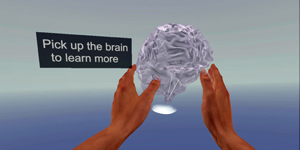
For aging services organisations, like home health care and senior living providers, they have gotten their infectious disease protocols under control and are training as they were before with Embodied Labs, finding that the empathy and power of the training help rejuvenate the spirits of our essential workers who have been through an unprecedented level of stress as they’ve battled the pandemic face on.
Aging services organisations are also incorporating remote training into online caregiver support groups and using it to do community outreach and education. Now more than ever, older adults are in the spotlight as they are most vulnerable to COVID-19. Our training platform and content address health issues that older adults face in a deep way that now more than ever, our society must address.
Coming up for Embodied Labs
Today, we have expanded our platform to deliver hardware/software and remote training experiences to any aging-services organisation in the world. Over the next 12 months, we will be announcing a host of exciting new developments and financing opportunities.
For me personally, I am thrilled to see Embodied Labs grow at an exponential rate as the challenge to build and lead a team with a culture of care, critical kindness and inclusion brings me joy each and every day. Embodied Labs embodies all that my mom raised me to be – curious, creative, and kind at the service of doing the most to leave the world a better place than when I entered it.
https://embodiedlabs.com/
https://twitter.com/embodiedLabs
https://www.linkedin.com/in/carrieeshaw/

